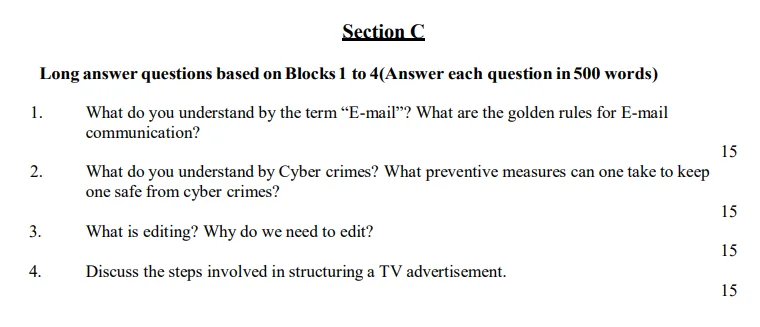BEGG 171 SOLVED IGNOU ASSIGNMENT FREE PART 3

Embark on the in-depth exploration of Media and Communication Skills BEGG 171 SOLVED IGNOU ASSIGNMENT FREE PART 3 in Section C with our meticulously crafted IGNOU Solved Assignments 2024. Tackle long answer questions based on Blocks 1 to 4, offering comprehensive insights into each topic within 500 words. Define the intricacies of ‘E-mail’ and explore the golden rules for effective communication. Dive into the realm of cyber crimes, discussing preventive measures. Uncover the essence of editing and its necessity, and dissect the steps involved in structuring a TV advertisement.

Long answer questions based on Blocks 1 to 4 (Answer each question in 500 words)
Q.1 What do you understand by the term “E-mail”? What are the golden rules for E-mail communication?
Ans. Email, short for electronic mail, is a widely used method of exchanging digital messages between people using electronic devices, typically through the internet. It has become a fundamental communication tool for personal and professional interactions. An email consists of a message, usually in text format, and can include attachments such as documents, images, or links.
Golden Rules for E-mail Communication:
Effective email communication is essential for conveying messages clearly and professionally. Adhering to certain golden rules ensures that your emails are well-received and contribute positively to your communication efforts:
1. Clear and Concise Subject Line:
– The subject line is the first thing recipients see. Make it clear, concise, and relevant to the content of your email. A well-crafted subject line helps recipients understand the email’s purpose and urgency.
2. Professional Tone and Language:
– Maintain a professional tone and use formal language, especially in a professional or business context. Avoid using all caps (considered shouting) and be mindful of cultural differences that might affect interpretation.
3. Consider the Audience:
– Tailor your communication to the audience. Be aware of the recipient’s role, level of familiarity, and expectations. Adjust your tone accordingly, whether you are writing to a colleague, supervisor, or client.
4. Mindful of Length:
– Keep your emails concise and to the point. Most people appreciate brevity, and long-winded emails may result in key points being overlooked. If your email is lengthy, consider whether it might be more appropriate as a separate document.
5. Use Proper Grammar and Spelling:
– Correct grammar and spelling contribute to the professionalism of your communication. Proofread your emails before sending them to avoid misunderstandings and present yourself as someone who pays attention to detail.
6. Respond in a Timely Manner:
– Aim to respond promptly to emails. Even if you cannot provide a detailed response immediately, acknowledge receipt of the email and communicate when the recipient can expect a more comprehensive reply.
7. Be Mindful of Attachments:
– Clearly indicate if your email includes attachments, and ensure that the attachments are relevant to the email’s content. Consider compressing large files to prevent issues with the recipient’s inbox capacity.
8. Relevant and Descriptive:
– Make your email content relevant to the subject and ensure that the message is clear. Avoid unnecessary details that might confuse the recipient. Use descriptive language to convey your points effectively.
9. Use Cc and Bcc Judiciously:
– Use the Cc (carbon copy) and Bcc (blind carbon copy) fields thoughtfully. Only include recipients who genuinely need to be informed or are directly involved in the conversation. Bcc should be used when recipients should remain undisclosed.
10. Avoid Emotional Emails:
– If you are feeling emotional or upset, it’s best to delay sending an email. Emotional emails can be misinterpreted, and the written record of your emotions may not contribute positively to professional relationships.
11. Consider Privacy and Security:
– Be cautious about sharing sensitive information via email. Ensure that the content is appropriate for the medium and, if necessary, use secure channels for confidential information.
12. Follow-Up when Necessary:
– If your email requires a specific action or response, follow up if you don’t receive one within a reasonable timeframe. Polite follow-ups ensure that important matters are not overlooked.
Adhering to these golden rules enhances the effectiveness of your email communication, fostering clear, professional, and respectful exchanges in both personal and professional contexts.
Q.2 What do you understand by Cyber crimes? What preventive measures can one take to keep one safe from cyber crimes?
Ans. Cybercrime refers to criminal activities carried out through the use of computers, networks, and digital technologies. It encompasses a wide range of illicit activities conducted in the digital realm, targeting individuals, organizations, or governments. Some common forms of cybercrime include hacking, identity theft, phishing, ransomware attacks, and online fraud. As technology evolves, so do the methods employed by cybercriminals to exploit vulnerabilities in digital systems.
Preventive Measures to Stay Safe from Cyber Crimes:
Ensuring cybersecurity involves a combination of adopting secure practices, staying informed about potential threats, and utilizing available tools and technologies. Here are preventive measures to keep individuals and organizations safe from cyber crimes:
1. Use Strong Passwords:
– Create complex passwords with a mix of upper and lower case letters, numbers, and symbols. Avoid using easily guessable information like birthdays or names. Regularly update passwords and consider using a password manager for added security.
2. Enable Two-Factor Authentication (2FA):
– Implementing 2FA adds an extra layer of security by requiring users to provide two forms of identification before accessing an account. This can significantly enhance the protection of sensitive information.
3. Keep Software and Systems Updated:
– Regularly update operating systems, software applications, and antivirus programs. Updates often include security patches that address known vulnerabilities, reducing the risk of exploitation by cybercriminals.
4. Be Cautious with Emails and Links:
– Exercise caution when receiving emails from unknown or suspicious sources. Avoid clicking on links or downloading attachments from unverified emails, as these may contain malware or phishing attempts.
5. Install Reliable Antivirus Software:
– Install reputable antivirus and anti-malware software to provide real-time protection against malicious software. Keep the software updated to ensure it can detect and mitigate the latest threats.
6. Secure Your Wi-Fi Network:
– Set a strong, unique password for your Wi-Fi network to prevent unauthorized access. Use WPA3 encryption if available. Regularly check connected devices and remove any that you don’t recognize.
7. Backup Your Data:
– Regularly back up important data to an external device or a secure cloud service. In the event of a ransomware attack or data loss, having a backup ensures that critical information can be restored.
8. Educate Yourself and Others:
– Stay informed about the latest cybersecurity threats and trends. Educate yourself and your team about phishing techniques, social engineering, and other tactics used by cybercriminals to trick individuals into revealing sensitive information.
9. Limit Personal Information Online:
– Be mindful of the personal information you share online, particularly on social media platforms. Limit the details you make public, as cybercriminals may use this information for identity theft or targeted attacks.
10. Secure Your Mobile Devices:
– Apply security features such as passwords, biometrics, or PIN codes to your mobile devices. Keep mobile operating systems and applications updated to patch vulnerabilities.
11. Monitor Financial Transactions:
– Regularly review your financial statements and transactions for any unauthorized or suspicious activities. Report any discrepancies to your financial institution promptly.
12. Implement Security Policies at Work:
– Organizations should establish and enforce cybersecurity policies. This includes guidelines for password management, data protection, and employee training on recognizing and responding to cyber threats.
13. Use a Virtual Private Network (VPN):
– When accessing the internet, especially on public Wi-Fi, use a VPN to encrypt your internet connection. This helps protect your data from potential eavesdropping or interception.
14. Report Suspicious Activity:
– If you encounter any suspicious online activity or believe you have been a victim of cybercrime, report it to the appropriate authorities, such as your local law enforcement or cybersecurity agencies.
By implementing these preventive measures, individuals and organizations can significantly reduce their vulnerability to cyber crimes. Cybersecurity is an ongoing effort that requires vigilance, awareness, and a commitment to adopting best practices in the ever-evolving digital landscape.
Q.3 What is editing? Why do we need to edit?
Ans. Editing is a critical phase in the writing process that involves reviewing, revising, and refining written content to improve its clarity, coherence, and overall quality. It is a meticulous examination of a document with the goal of enhancing its readability, correctness, and effectiveness. Editing encompasses various aspects, including grammar, punctuation, syntax, style, organization, and overall structure.
Golden Rules for E-mail Communication:
The process of editing is indispensable in the realm of writing for several compelling reasons:
1. Clarity and Coherence:
– Editing ensures that the message conveyed in the written content is clear and coherent. It involves restructuring sentences and paragraphs to enhance the flow of ideas, making the text more comprehensible to the audience.
2. Grammatical Accuracy:
– Editing addresses grammatical errors, spelling mistakes, and punctuation issues. Correcting these elements is crucial for maintaining professionalism and credibility in written communication.
3. Consistency in Style:
– Editing ensures consistency in writing style and tone throughout a document. Consistency contributes to a polished and professional presentation, creating a cohesive reading experience for the audience.
4. Improved Structure and Organization:
– A well-edited document has a logical and organized structure. Editing involves arranging content in a manner that flows logically, with clear transitions between ideas and sections.
5. Enhanced Readability:
– Through editing, sentences are refined to improve readability. This involves varying sentence structures, eliminating unnecessary jargon, and using language appropriate for the target audience.
6. Elimination of Redundancy:
– Editors identify and remove redundant or repetitive information, ensuring that the content is concise and focused. Reducing redundancy enhances the impact of the message.
7. Correction of Ambiguities:
– Ambiguous language can lead to misunderstandings. Editors clarify ambiguous statements, ensuring that the intended meaning is accurately conveyed to the reader.
8. Adherence to Guidelines and Standards:
– In various contexts, such as academic writing, journalism, or business communication, there are specific guidelines and standards to follow. Editing ensures that a document adheres to these standards, whether they relate to citation styles, industry terminology, or formatting requirements.
9. Polished Presentation:
– Editing contributes to the overall polished presentation of a document. A well-edited piece of writing reflects professionalism, attention to detail, and a commitment to quality.
10. Audience Engagement:
– Understanding the target audience is essential in effective communication. Through editing, writers can tailor their content to resonate with the intended audience, increasing engagement and impact.
11. Error Prevention:
– Editing serves as a preventive measure against errors that could compromise the accuracy and integrity of the content. It helps catch mistakes before the document is published or shared.
12. Meeting Objectives:
– Whether the goal is to inform, persuade, entertain, or educate, editing ensures that the writing aligns with its intended objectives. This includes refining language and structure to achieve the desired impact.
13. Building Credibility:
– Well-edited content contributes to the credibility of the writer or organization. Errors and inconsistencies can undermine the audience’s trust, while a polished document enhances the author’s credibility.
14. Continuous Improvement:
– The editing process fosters a culture of continuous improvement in writing. By carefully reviewing and revising content, writers can identify areas for enhancement and develop their skills over time.
In essence, editing is a refining process that transforms a draft into a polished and effective piece of writing. It is an investment in the quality and impact of communication, reflecting a commitment to delivering clear, accurate, and compelling content to the audience. Whether in academic, professional, or creative contexts, the value of editing cannot be overstated in the pursuit of effective and impactful communication.
Q.4 Discuss the steps involved in structuring a TV advertisement.
Ans. Structuring a TV advertisement involves a strategic and creative process to effectively convey a message within a limited time frame. Here are the essential steps:
1. Define the Objective:
– Before creating an advertisement, clearly define the objective. Whether it’s raising brand awareness, promoting a specific product, or driving sales, a well-defined objective guides the entire creative process.
2. Know Your Audience:
– Understand the target audience for the advertisement. Consider demographics, interests, and preferences. Tailor the message and creative elements to resonate with the intended viewers.
3. Craft a Compelling Message:
– Develop a concise and compelling message that aligns with the advertising objective. The message should be memorable, evoke emotions, and highlight the unique selling proposition (USP) of the product or service.
4. Storyboarding:
– Create a visual storyboard that outlines the sequence of scenes in the advertisement. This serves as a blueprint for the visual elements, transitions, and the overall flow of the ad.
5. Scriptwriting:
– Write a script that complements the storyboard. The script includes dialogues, voiceovers, and any narrative elements. It should be engaging, align with the brand’s tone, and effectively convey the message.
6. Choose the Right Tone and Style:
– Determine the tone and style of the advertisement. Whether it’s humorous, emotional, informative, or dramatic, the tone should resonate with the target audience and align with the brand’s identity.
7. Select Music and Sound Effects:
– Choose music and sound effects that enhance the emotional impact of the advertisement. The right audio elements can significantly contribute to the overall effectiveness of the ad.
8. Plan Visual Elements:
– Plan the visual elements, including settings, characters, and props. Ensure that visuals are captivating, relevant, and align with the brand image. Consider the use of colors, lighting, and cinematography techniques.
9. Time Management:
– Given the limited time in a TV advertisement, efficient time management is crucial. Allocate time wisely to each segment of the ad, prioritizing key messages and visuals.
10. Create a Strong Opening:
– The opening seconds of a TV ad are crucial for capturing audience attention. Create a strong and intriguing opening that encourages viewers to stay engaged. This could involve a compelling visual, a thought-provoking question, or an attention-grabbing statement.
11. Highlight Benefits:
– Clearly communicate the benefits of the product or service. Viewers should understand what sets it apart and why they should consider it. Focus on addressing the needs and desires of the target audience.
12. Include a Call to Action (CTA):
– Every TV ad should have a clear call to action. Whether it’s visiting a website, making a purchase, or participating in a promotion, guide viewers on what steps to take next.
13. Test and Iterate:
– Before finalizing the advertisement, conduct focus group testing to gather feedback. Use this feedback to make necessary adjustments and refine the ad for maximum impact.
14. Adherence to Regulations:
– Ensure that the advertisement complies with relevant regulations and guidelines. This includes adhering to advertising standards, avoiding misleading claims, and following industry-specific rules.
15. Production and Editing:
– Once the script, storyboard, and visual elements are finalized, proceed with the production and editing of the advertisement. Pay attention to details such as transitions, pacing, and overall visual and audio quality.
16. Media Planning and Placement:
– Develop a media plan to determine when and where the advertisement will be aired. Consider the target audience’s viewing habits and choose channels and time slots that align with the campaign objectives.
17. Measure and Analyze Performance:
– After the advertisement has been aired, track its performance. Analyze key metrics such as reach, engagement, and conversion rates. Use this data to evaluate the effectiveness of the advertisement and inform future campaigns.
In conclusion, structuring a TV advertisement requires a strategic approach that combines creativity, storytelling, and a deep understanding of the target audience. By following these steps, advertisers can create impactful and memorable TV commercials that effectively communicate their message and achieve the desired results.
Also See This: BEGG 171 SOLVED IGNOU ASSIGNMENT FREE PART 1







